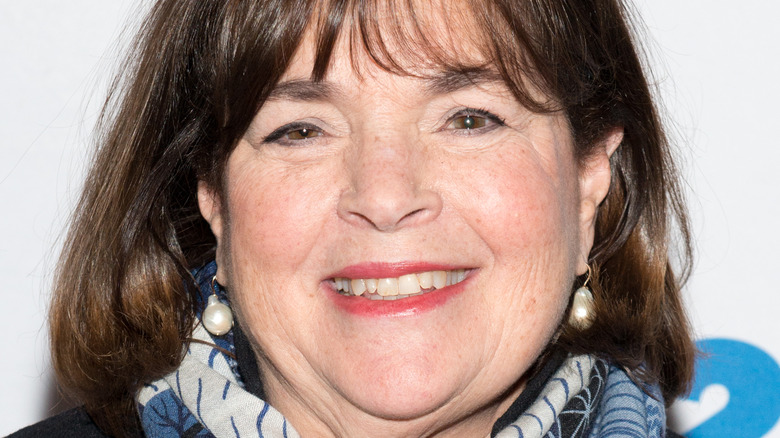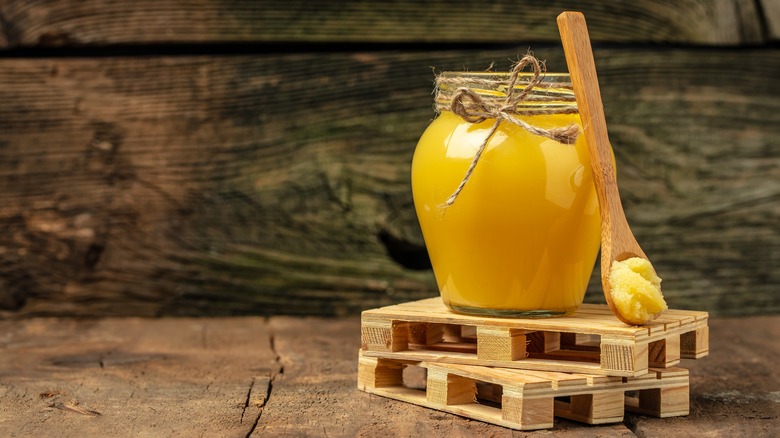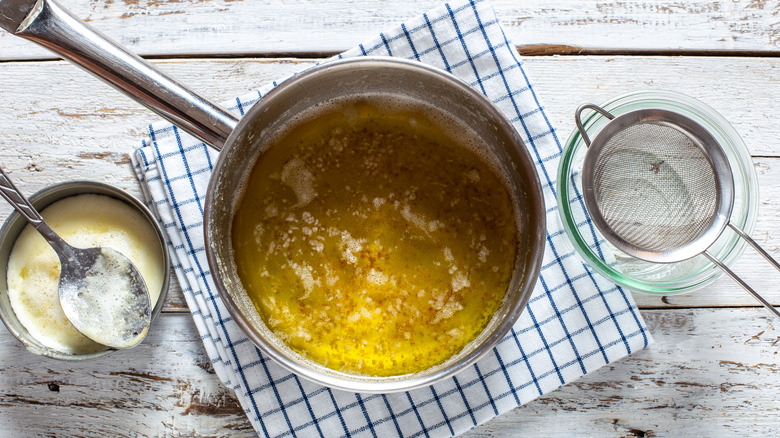Ina Garten's Genius Advice To Cook With Butter Over High Heat
There's plenty of precious cooking wisdom that fans have picked up from the Barefoot Contessa over the years — but considering her reputation for straightforward, no-fuss recipes that just about anybody can follow, some of her best tips have had to do with using basic pantry staples like butter. Burgers turning out dry as sand? Ina Garden suggests plopping some cold butter on the patties. Want to amp up the flavor of everyday meals? Splurge on a stick of truffle butter, she says. Burnt butter making fluffy pancakes and crisp French toasts taste bitter? Garten recommends clarifying it!
Anybody who has tried to cook with butter on high heat will know it's tricky. Yes, believe it or not, even butter has its pitfalls. This is because it's primarily composed of three things: water, fat, and milk solids. When you melt regular butter in a pan under direct high heat, you also expose the milk solids to the heat. These will burn and turn everything into a bitter, brown-colored liquid flecked with burnt black bits — a situation that you're unlikely to face with clarified butter.
By turning it into clarified butter or ghee, however, you rid the butter of its milk solids and increase its smoke point. Where butter begins to burn at approximately 300 degrees Fahrenheit, clarified butter has a higher smoke point of 465 degrees. This is why, if you're using high heat, it's best to take Garten's advice: Stick to clarified butter. How do you clarify it? Easy! Microwave it.
What is clarified butter and why is it better than regular butter?
Butter is essentially 80% fat. The other 20% is comprised of water as well as proteins and sugars that make up the heat-sensitive milk solids. Clarified butter is made by heating butter until the milk solids, water, and fat separate from each other. As the butter melts and simmers, the milk solids present in it sink to the bottom, and the water boils and evaporates. All that's left (after the scum that forms on the top is skimmed) is a layer of pure golden fat that can be filtered for the sunken milk solids. This layer of fat is what's known as clarified butter, or liquid gold.
There are ways to prevent the standard butter from burning of course; you could use appliances that regulate heat at an even temperature, spike the butter with a splash of oil, or only use butter in small batches. But if you'd like to fry up some eggs, whip up pancakes, or sauté veggies on direct high heat without worrying about the butter burning, clarified butter will be much easier to work with. As a bonus, clarified butter will also add a toasted, nutty, caramel-like flavor to anything you cook in it.
How to make clarified butter the Ina Garten way
While clarified butter makes high-heat cooking a breeze compared to butter, there is a price to pay for it. Due to its labor-intensive nature and the volume of liquid that's lost, it tends to come with a noticeably higher price tag. Luckily, you can always make clarified butter at home, and all you need is a few sticks of unsalted butter to get started.
Clarified butter is usually made by melting butter and boiling it until the milk solids form a layer of white foam on the top before eventually falling to the bottom. When the bubbling comes to a stop — a sign that all the water is gone — and the white foam sinks, all you're left with is a golden liquid that can be strained and used as clarified butter.
Alternatively, Garten has a much simpler method. In a "Cook Like a Pro" segment, Garten says that she simply microwaves her butter to clarify it! Per her method, all you need to do is pop some butter in a heat-safe pitcher, microwave it for 30 seconds until everything melts, and wait for the milk solids to separate and settle at the bottom. She then proceeds to pour the pure golden liquid floating at the top directly into her pan — which means that her method doesn't involve straining the milk solids out — you should have clarified butter in under a minute using the Barefoot Contessa's hack.



